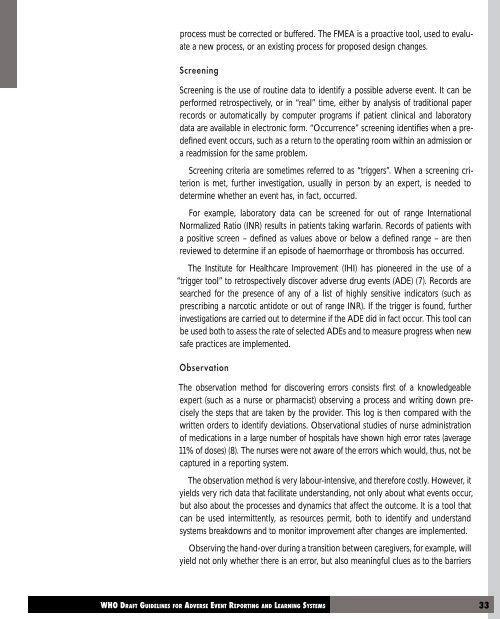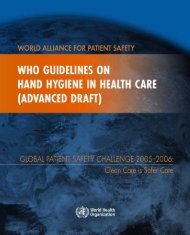Adverse event reporting.pdf
Adverse event reporting.pdf
Adverse event reporting.pdf
Create successful ePaper yourself
Turn your PDF publications into a flip-book with our unique Google optimized e-Paper software.
process must be corrected or buffered. The FMEA is a proactive tool, used to evaluate<br />
a new process, or an existing process for proposed design changes.<br />
Screening<br />
Screening is the use of routine data to identify a possible adverse <strong>event</strong>. It can be<br />
performed retrospectively, or in “real” time, either by analysis of traditional paper<br />
records or automatically by computer programs if patient clinical and laboratory<br />
data are available in electronic form. “Occurrence” screening identifies when a predefined<br />
<strong>event</strong> occurs, such as a return to the operating room within an admission or<br />
a readmission for the same problem.<br />
Screening criteria are sometimes referred to as “triggers”. When a screening criterion<br />
is met, further investigation, usually in person by an expert, is needed to<br />
determine whether an <strong>event</strong> has, in fact, occurred.<br />
For example, laboratory data can be screened for out of range International<br />
Normalized Ratio (INR) results in patients taking warfarin. Records of patients with<br />
a positive screen – defined as values above or below a defined range – are then<br />
reviewed to determine if an episode of haemorrhage or thrombosis has occurred.<br />
The Institute for Healthcare Improvement (IHI) has pioneered in the use of a<br />
“trigger tool” to retrospectively discover adverse drug <strong>event</strong>s (ADE) (7). Records are<br />
searched for the presence of any of a list of highly sensitive indicators (such as<br />
prescribing a narcotic antidote or out of range INR). If the trigger is found, further<br />
investigations are carried out to determine if the ADE did in fact occur. This tool can<br />
be used both to assess the rate of selected ADEs and to measure progress when new<br />
safe practices are implemented.<br />
Observation<br />
The observation method for discovering errors consists first of a knowledgeable<br />
expert (such as a nurse or pharmacist) observing a process and writing down precisely<br />
the steps that are taken by the provider. This log is then compared with the<br />
written orders to identify deviations. Observational studies of nurse administration<br />
of medications in a large number of hospitals have shown high error rates (average<br />
11% of doses) (8). The nurses were not aware of the errors which would, thus, not be<br />
captured in a <strong>reporting</strong> system.<br />
The observation method is very labour-intensive, and therefore costly. However, it<br />
yields very rich data that facilitate understanding, not only about what <strong>event</strong>s occur,<br />
but also about the processes and dynamics that affect the outcome. It is a tool that<br />
can be used intermittently, as resources permit, both to identify and understand<br />
systems breakdowns and to monitor improvement after changes are implemented.<br />
Observing the hand-over during a transition between caregivers, for example, will<br />
yield not only whether there is an error, but also meaningful clues as to the barriers
















